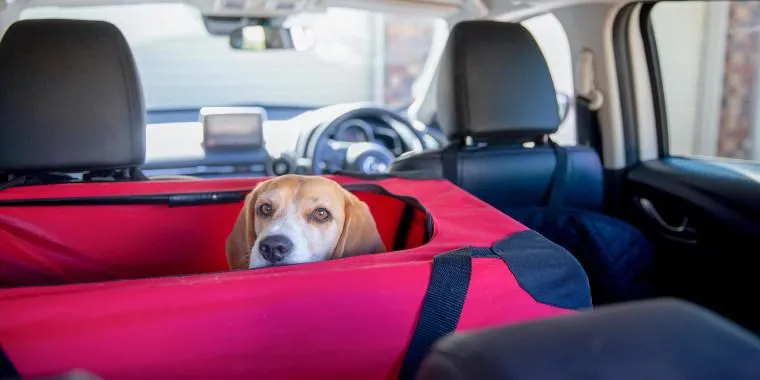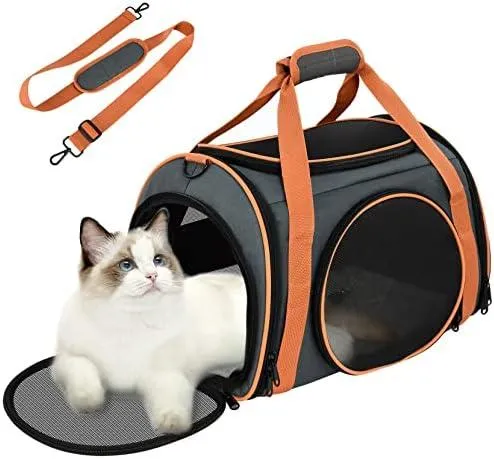Your Comprehensive Guide to Choosing the Best Pet Carrier
Whether you’re traveling by car or plane with your furry friend, using the right pet carrier is essential to keeping them safe and comfortable. With so many carrier options on the market, it can feel overwhelming to choose one. In this article, I’ll break down the main types of carriers and things to consider so you can pick the best pet carrier for your pet’s needs.
Types of Pet Carriers
- Soft-Sided Carriers: Made of fabric like nylon or mesh, these flexible carriers are lightweight and easy to fold up for storage. They’re great for smaller pets but may not provide as much structure or security as other options. From my experience, they kind of work better for shorter trips where your pet won’t be cooped up for hours.
- Hard-Sided Carriers: With rigid plastic or metal frames, these carriers offer more durability and protection for your pet. The structure gives pets a sense of security too. However, hard-sided carriers tend to be heavier. I usually go with one of these for longer road trips with my pup to give him that sense of sturdiness, you know?
- Backpack Carriers: Wearing your pet on your back hands-free, these carriers are convenient for hiking or traveling. Make sure to get one with well-padded straps so it’s comfortable to tote Fido all day. In my opinion, these are perfect if you’ll be doing a lot of walking around with your pet.
Additional Considerations
When choosing a carrier, consider your pet’s size, temperament, and the context in which you’ll be using it. Some other important factors:
Ventilation: Look for multiple openings, mesh panels, or air holes to keep air circulating. You don’t want your buddy overheating!
Ease of Cleaning: Accidents happen. Choose a carrier with removable, washable liners or surfaces that can be wiped down.
Handles/Straps: Make sure the carrier is easy for you to grab and lift, especially if your pet is large. Backpack straps should fit you comfortably.
Collapsibility: Carriers that fold up pequeño-style are neater for storage in car trunks or overhead bins. Rigid ones save space too.

Safety Features: Look for secure zippers or latches, reinforced corners, and a protection guarantee if it’s an airline-approved hard carrier.
Basically, do your research to find a carrier with all the bells and whistles your pet situation requires. But is it worth spending a ton of moolah if Fido will only use it once in a blue moon?
Carrier Training Takes Time
No matter how comfortable the carrier, expect some freak outs at first. Like it takes dogs time to get used to, well, pretty much everything! Start training early by feeding pets in the carrier and leaving it around the house with a cozy bed or toy inside.
Gradually work up to short practice trips around the block before any big hauls. Bring along favorites like a well-worn blanket or chew toy. And always reward calm behavior inside with treats and praise. It sorta takes them a while to realize the carrier isn’t a punishment – they just get nervous like we all do riding in strange new places!
With patience and positive association, even the biggest scaredy-cats can learn to feel safe enclosed. And that makes stressful trips way smoother for everyone involved.
Air Travel Precautions
If flying with pets, check airline policies carefully. Most require pets to stay in carriers under the seat in front of you for the entire flight. But is that seriously fair if we have to spend hours cramped like that too?

Anyhow, it’s still smart to check your carrier meets proper size limitations posted. And remember not all dogs do well with change in air pressure – see your vet about mild anxiety meds if needed.
Always identify carriers externally with name, contact info, and “Live Animal” signs. Consider pet travel vests with these details for visual ID too in case the carrier is misplaced. Basically, the more precaution, the less stress all around.
Safety is key travelling by plane with furry friends. Follow airline rules to a T and your pet will be home again in no time, even if the trip was absolutely bonkers!
Final Thoughts
With so many great carrier options on the market, you’re sure to find one tailored to your pet’s type and travel needs. Compare features, read reviews online, and envision how you’ll be using it before selecting the best pet carrier.
Most importantly, take time for carrier training practice runs together. It’ll help your pet feel more at-home come moving day. Safe travels, and happy adventures with your four-legged buddy! Let me know if you have any other pet travel questions.
Top Pet Carriers for Your Furry Friend
| Type | Size | Material | Features | Best For |
|---|---|---|---|---|
| Hard-Sided | Small to Large | Plastic or Metal | Secure, Ventilation openings, Easy-clean | Air travel, Long car rides |
| Soft-Sided | Small to X-Large | Fabric | Lightweight, Padded, Multiple pockets | Everyday use, Short trips |
| Backpack | Small to Medium | Nylon | Ventilated mesh, Adjustable straps, Accessories pocket | Hiking, Outdoor activities |
| Collapsible | Small to Medium | Plastic or Fabric | Folds flat for storage, Easy-clean, Breathable mesh | Travel, Home, Apartments |
| Car Seat | Small to Medium | Fabric | Seatbelt slots, Padded, Removable bottom | Car rides, Easy monitoring |
FAQ
-
What is the best size for a pet carrier?
The right size basically depends on your pet. For smaller dogs and cats, look for something around 10-15 inches wide. Medium pets might need 18-20 inches. Larger dogs could require up to 24 inches wide. Of course, you want them to fit in without being crammed but also not able to move around too much. Too much space can lead to anxiety for some pets, believe it or not!

-
Should I get a soft or hard carrier?
This one is sort of up to personal choice. Hard carriers offer more protection but soft ones are usually lighter and cooler for the pet. Perhaps the amazing folks at your local pet store can assist in picking what suits Fido or Fluffy best. They see so many animals there! At the same time, some experts say soft carriers can make pets feel less confined. So there are good points to both.
-
How do I introduce my pet to a carrier?
Gradually is definitely the way to go here. Leaving the carrier out with some treats or toys inside lets them get familiar without pressure. Then do short practice sessions with praise and affection. Over time, boost the reward during sessions. It reportedly helps to feed your pet in the carrier too. Patience will pay off – your pal will start seeing it as a positive place. Try to always use happy tones when dealing with the carrier.
-
Will my pet be distressed in the carrier?
Possibly, unfortunately. Every animal is different, after all. Some adapt to carriers easily while others apparently really stress out. To minimize anxiety, consider covering the carrier with a towel to calm them. You could maybe also play calming music or ask your vet about anti-anxiety remedies in extreme cases. Communication with your vet is key if distress seems to persist. The poor dear!
-
What else do I need to pack for travel?
In addition to the carrier, be sure to bring:
– Your pet’s ID tags with updated contact info in case they wiggle free from the carrier
– A favorite blanket or toy for comfort
– Paper toweling or puppy pads in case of “accidents”
– Extra plastic bags for clean up
– Water and a small bowl if it’s a longer trip
– Any medications with instructions
– Recent medical records and vaccination info
– Backup plans and contacts in case of delays -
How do I keep my pet comfortable in the car?
Place the carrier in a safe, stable area like the seat or cargo area away from any luggage that could fall. Unless it’s a hot day, the AC vent pointed away is good ventilation. Play calming music or an audiobook at a low volume. Make gradual stops to let them potty. Comfort them if needed but avoid unintended overstimulation. Perhaps give a stuffed Kong or other long-lasting chewable for distraction. Traveling with pets takes effort but their safety and peace of mind are so important.
-
Is there a “best” type of carrier to use?
Hmm, experts probably disagree on that one! Soft carriers have their advantages like being lightweight and usually more relaxed for pets. However, the extra safety of a hard shell is something to consider – it seems those types guard against potential injuries better. In the end, it really depends on your pal. Their personality and what makes them most at ease should be the top priority here. Maybe chat with other pet owners facing similar choices too! You never know what someone else’s experience can teach you.

